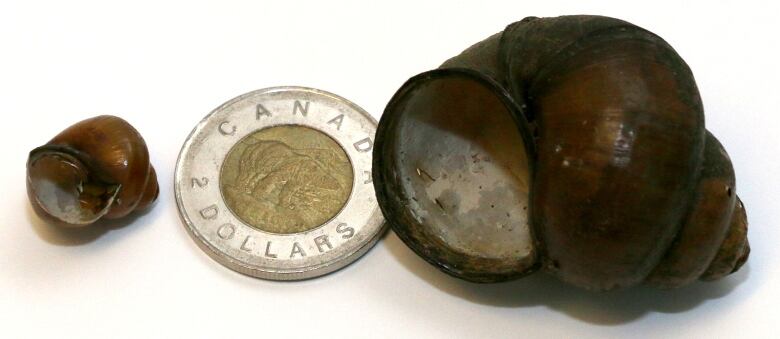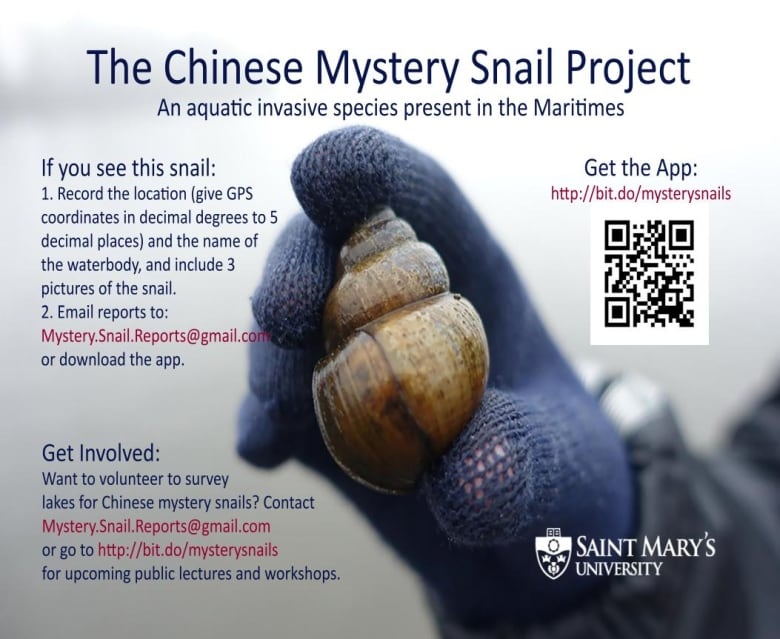Scientists ask for help to solve snail 'mystery'
Saint Mary's graduate student studies risk to lakes and rivers from potentially invasive species

A new snail is moving into some Maritime lakes and rivers. And scientists are enlisting citizen scientists to help them find out just how widespread it's become.
The Chinese mystery snail is a potentially invasive species, says Sarah Kingsbury, a graduate student in environmental science at Saint Mary's University in Halifax.
The snail can change the water chemistry by altering nitrogen and phosphorus levels, she said.
And it can out-compete native species.
"It's much larger than they are. It's about two to three times larger than our largest native species. And it's really resistant to predation. So, it's really good at surviving and adapting to new environments."
Found in Sackville area, Grand Lake
In New Brunswick, the Chinese mystery snail was known to be present in some isolated lakes in the Sackville area, going back a few years, said Don McAlpine, curator of zoology at the New Brunswick Museum.
In 2016, the snails were also found in the Grand Lake area.
"That's a little bit more concerning that means the snail potentially has access to the whole St. John River watershed," he said.
Chinese mystery snails are described as about the size of a small clementine and are brown to almost black in colour.
They have a "trapdoor" shell feature, that can seal the snail within its shell.

This feature, called an operculum, allows the snail to survive long periods out of water, making it easy to transport in the hold of a ship, said McAlpine,
"There's a relationship between the presence of these snails and boat landings. So the suggestion's been that a lot of them have been spread around that way."
McAlpine said Chinese mystery snails probably first came to North America around 1890 as a food source for Chinese labourers working on the railroad.
Dumped from aquariums
"I've never eaten one myself, but they're probably a pretty good source of protein," he said.
They turned up on the East Coast, in Massachusetts, not long after and are now being spread around mainly through the aquarium and water-garden industries.
"They sometimes get dumped into lakes and rivers when people get rid of aquariums," said McAlpine, adding the snail is able to survive Canadian winters.
McAlpine and his colleagues published a paper about the Chinese mystery snail in 2016.

Kingsbury hasreceived a small grant from the New Brunswick Museum this year to help support her work in the province.
The body of research on the species is quite small, she said.
For instance, nothing has been published on the origin of its name.But there are a couple of theories.
One purports that the "mystery" surrounds its sex.
"You can't tell the sexes a lot of the time," said Kingsbury.
Females have two long, straight tentacles and males have one long, straight tentacle and one short, curved tentacle.
Stay in shells
"But you can't really see that because they spend a lot of time inside their shell or in lakes where you can't see the bottom very well."
The snails pretty much have to be on glass to tell the difference, she said.
According to the other theory, the real mystery is whether the snail is pregnant.

While most native species of snails lay an egg sac, the Chinese mystery snail gestates young inside itself, "kind of like humans."
"Then they give birth to fully developed, crawling young. So, you don't always know if they're pregnant. You just end up with all these babies everywhere."
Kingsbury is asking people to report snail sightings by email at mystery.snail.reports@gmail.com, via the website bit.do/mysterysnails, or by using their mobile app.
She's trying to figure out which lakes and rivers are most at risk.
That work also involves creating a computer model that takes in data about water chemistry, such as dissolved calcium, acidityand water depth, and human factors, such as how often the lake is used, whether it's stocked with fish and whether other invasive species are already present in the area.
Kingsbury plans to categorize lakes in New Brunswick, Nova Scotia and Prince Edward Island as low-, medium- or high-risk and pass that information on to invasive species managers.
With files from Information Morning Saint John












_(720p).jpg)


 OFFICIAL HD MUSIC VIDEO.jpg)
.jpg)



























































































